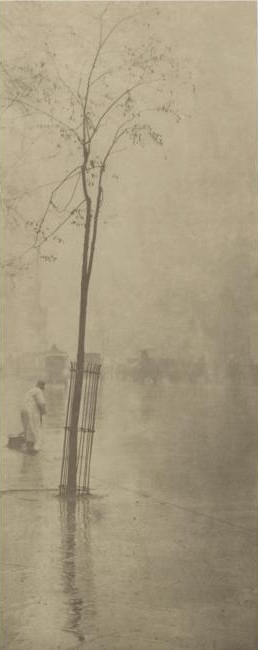One of the concepts brought into question with the introduction of photography is MEMORY.
Think about what our photographs mean to us, how they represent memories for us. This is one of the reasons why we preserve certain images in albums and frames.
Your assignment is to photograph MEMORY. Think about how you can make this abstract concept concrete. Please be creative.
Some examples of photographs as MEMORY; click on the name of the photographer or photograph for more information ...
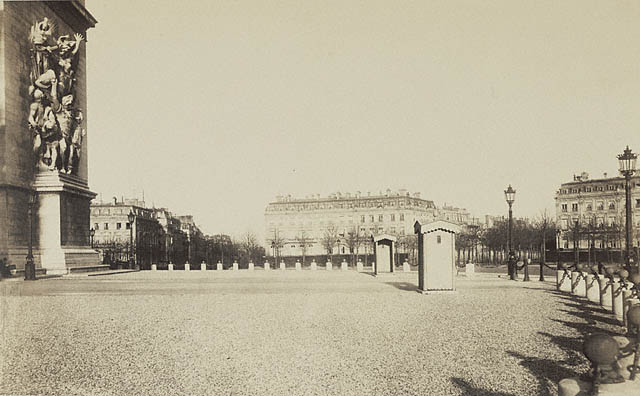
Charles Marville, Place de l'Etoile
c. 1877
In the late 1850s, Paris was not the Paris of today, rather it was dirty, dark, and crowded. Napoleon decided that, in order to make Paris the city that it should be, it would undergo reconstruction and he enlisted the help of Baron Haussmann, a French administrator, to do this. Haussmann divided the city into sections or arrondissement to create the modern Paris (the main street in Paris, much like NYC's Broadway, is the Boulevard Haussmann). Since many buidlings were going to be torn down, photographers, Marville being one of them, were hired to photograph the Paris that would soon no longer exist, the Paris that only existed in memory. So, you may visit the Place de l'Etoile today and not find everything you see in this image. Additionally, photographs were needed for anything that was being taken apart to be cleaned (monuments, for example); the photos would then provide a guide on how to put these things back together.
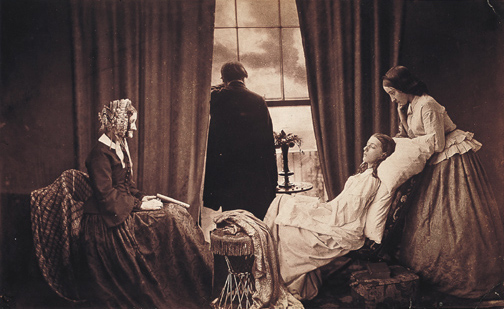
Henry Peach Robinson, Fading Away
1858
Since its introduction, photography has always fought for its place in the arts. Initially, it was seen as a mechanical process, where photographers were known as camera operators who simply recorded images. As more photographers started to see its artistic merits, they thought that photography should be the equal of painting and anything that could be done to achieve this should be done to achieve this. One such photographer was Henry Peach Robinson.
Robinson espoused Pictorialism, which sought to elevate photography through the portrayal of emotional, allegorical themes, as seen in his Fading Away. In this image, we see a woman on the chaise who is dying, surrounded by her mother and younger sister or daughter, representing the cycle of life. At the window, is her father, or maybe husband, as dark clouds loom on the horizon. Look closely and you may notice a resemblance between the three women because they are all portrayed by the same women. This was achieved through combination printing, a cut-and-paste technique that was much like 19th-century Photoshop work. Here's how it worked: after planning the image, the separate photos would be taken, printed, cut and pasted together (it was also often coated with wax or varnish to seal any gaps), and finally rephotographed. These images proved to be very popular with the public, but not all photographers thought Pictorialism was the way to go ...
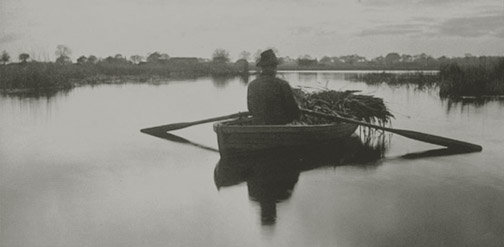
Peter Henry Emerson, Rowing Home The Schoof-Stuff
c. 1885
Unlike Robinson, Peter Henry Emerson did not think photography should aspire to be the equal of painting. Rather, he thought that it should develop its own visual language and be appreciated for what makes it unique, namely photography's ability to capture light, as seen in this image of his. Emerson called his approach Naturalistic Photography, eventually publishing a book by the same name in 1889. Emerson spent much of his time photographing the people of the Norfolk Broads in eastern England. Even at this time of industrialization, these were people who were living off the land, much as their ancestors had.
The merits of Pictorialism and Naturalistic Photography were much debated and interestingly, in 1891, Emerson suddenly said I'm worng, forget Naturalistic Photography, Pictorialism is the way to go ... and it become the dominant form of photography into the 1920's.
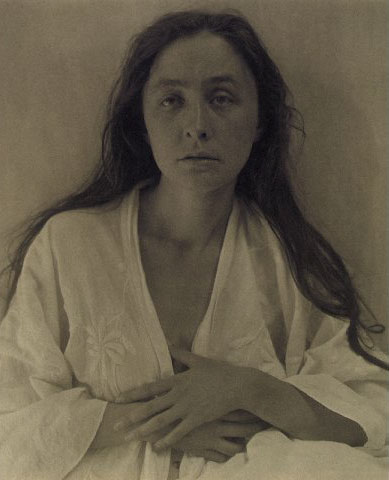
Alfred Stieglitz, Georgia O'Keeffe
1918
This is one of Stieglitz's early portraits of the artist Georgia O'Keeffe, part of a series of portraits he took of her over 20 years, and what is often considered to be some of his best work. Pictorialist with its warm tones and soft focus, there is a certain intimacy to this photo, almost as if the camera had disappeared, due in part to the relationship of Stieglitz and O'Keeffe (they marry in 1924).
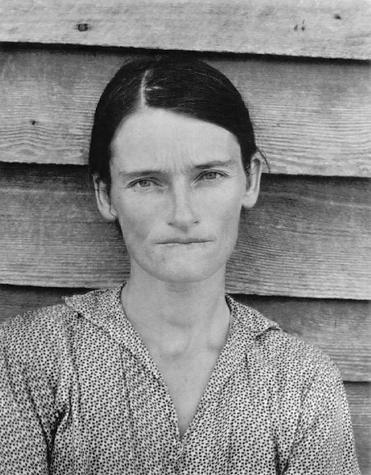
Walker Evans, Tenant Farmer's Wife, Alabama
(Allie Mae Burroughs)
1936
Compare the O'Keeffe portrait to this one of Allie Mae Burroughs by Walker Evans. It is not Pictorialist at all; it is direct, colder, sharply focused ... and an example of Modernism. Although it follows Pictorialism, Modernism has its basis in Emerson's Naturalism, relying on the inherent visual aesthetiic of photography rather than manipulation.
During the Great Depression, Evans was one of the photographers who worked for the FSA or Farm Security Administration. When FDR enacted the New Deal as a way to bolster the economy, the FSA sent photographers around the country to show that the New Deal was needed and was working. In some ways propaganda, they were given scripts to follow of what to shoot. Evans routinely threw these away, photographing what he wanted. Much like Marville and Paris during the reconstruction, Evans and the other FSA photographers were capturing a time in America that, hopefully, would soon be a thing of the past.
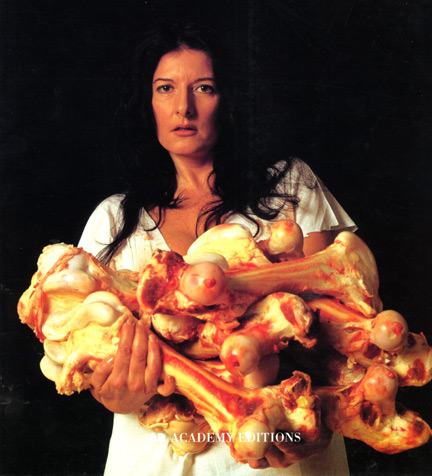
Marina Abramovic, Balkan Baroque
1997
In the 1960's and 1970's, artists began to question the concept of the art object and moved towards using the body as a vehicle for expression through Performance Art. These art events were often performed only once, at a specified time and place, and relied on photography and video as document. In this way, the performance would then continue to exist, interestingly, as an art object.
One of the pioneers of Performance Art is Marina Abramovic, who continues to perform today and recently had a retrospective at the Museum of Modern Art in New York City. She performed her piece Balkan Baroque at the Venice Biennale in 1997, for which she won the Golden Lion for best artist. In this piece, a reaction to the war in Bosnia, she sat on top a huge pile of cattle bones, trying to scrub them all clean.
This photograph by Alfred Stieglitz is an example of what Pictorialism evolved into. Although, combination printing was no longer used, photographers turned to soft-focus lenses and alternative printing techniques (platinum, gum bichromate, photogravure) to add a painterly effect to their images.
Stieglitz is an important name in American photography, especially in helping to establish it as an art form. Born in Hoboken, he went to Germany to study engineering, but became interested in photography. He joined a camera club while in Europe and was impressed by the aesthetic and critical discussions about this new art form. He also became friends with Peter Henry Emerson and helped translate his book, Naturalistic Photography, into German.
When he returned to the States, he decided to join a camera club here, hoping to continue the kind of discourse he had in Europe, only to find discussions about vacation photos, etc. Determined to establish photography as a fine art, he starting working at Camera Notes, the publication of the Camera Club of New York. Unfortunately, his view of critical discourse was not shared by everyone and he was asked to leave. In response, Stieglitz started his own publication, Camera Work, and also opened the 291 gallery, so named because it was located at 291 Fifth Avenue in New York City. Here, photography was displayed along with paintings and sculptures, as a way of saying that it was no different than these other art forms.
MEMORY






